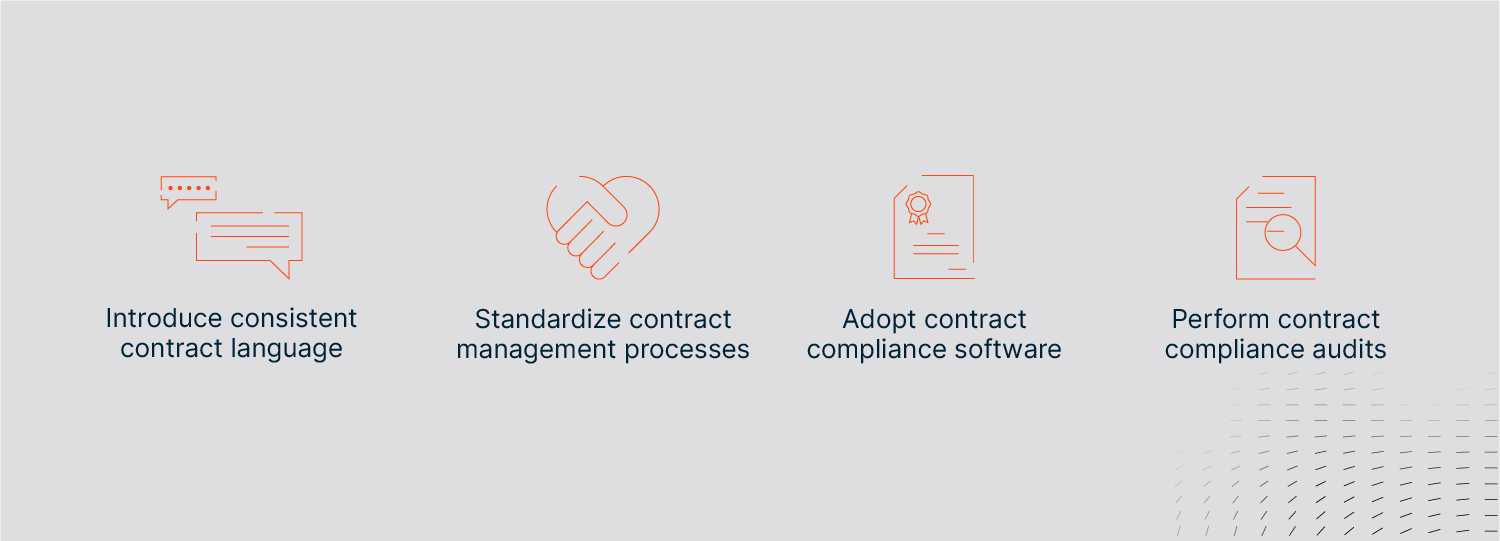Private funds’ contract compliance has become more complex in recent years due to growth in the private markets, fierce deal competition, business complexity, and regulatory scrutiny. These issues are expanding firms’ legal workloads, including tasks related to obligation management.
To add to fund managers’ challenges, many firms have reactive obligation management programs that can’t adequately scale with the rising workloads. Firms continue to rely on manual processes, spreadsheets, expensive outside counsel, and disparate software solutions.
Firms must evolve and implement mature contract compliance programs supported by industry-specific legal tech and artificial intelligence (AI).
What is contract compliance?
Contract compliance refers to a person or organization meeting the obligations they agreed to in their contracts, including those with vendors, business partners, investors, and employees.
What is a contract compliance program?
An obligation management program — aka a contract compliance program — includes the policies, procedures, and technology solutions an organization uses to reduce the risk of breaching a contract. The program might also dictate how firms address contract-related disputes.
Certain best practices, like implementing obligation management software, help firms maintain a mature obligation management program. By providing stakeholders with easy access to agreements and fund documents through a searchable contract repository, firms eliminate the possibility of a single point of failure and reduce reliance on outside counsel.
Common private fund contracts
Private fund managers must comply with the investor obligations in their limited partnership agreements (LPAs) and side letters.
An LPA is the controlling agreement between the general partner (GP) and a funds’ limited partners (LPs). It contains terms related to the duration of the fund, the fundraising period, the investment period, the GP’s commitment to the fund, management fees, carried interest, distributions, and the limited partner advisory committee.
A side letter agreement is a unique contract negotiated between a GP and an LP to modify or add to the terms in the LPA. Funds can have numerous and varied side letters, creating additional obligations with which GPs must comply.
What is the difference between contract compliance and regulatory compliance?
Contractual obligations and regulations both fall under the umbrella of compliance. However, contract and regulatory compliance differ in how obligations arise. Contract compliance stems from the firm’s agreements with its investors and other parties. Regulatory compliance stems from agency-promulgated rules. In the U.S., the Securities and Exchange Commission (SEC) and the Financial Industry Regulatory Authority (FINRA) oversee registered investment advisers and firms, broker-dealers, and national securities exchanges.
Contract and regulatory compliance also differ in the effects of noncompliance. Breaching a contract with an investor or another party could lead to civil litigation, an injunction, or damages. A regulatory violation could lead to administrative proceedings, civil lawsuits involving the SEC, enforcement actions, and fines.
What are the challenges of contract compliance management?
Private fund managers face myriad compliance concerns, ranging from the SEC’s focus on fees, expenses, and reporting to valuation policies, material nonpublic information, and bespoke side letter provisions. Compliance is an all-encompassing endeavor made harder by the volume and complexity of a fund manager’s agreements.
Additionally, tracking contract obligations is often challenging because of several common issues.
1. Manual processes
Firms often rely on spreadsheets and compendia put together by outside counsel to track obligations to investors and lack a searchable, central contract repository. While in-house lawyers and business professionals can use a spreadsheet’s search feature, those search capabilities are neither powerful nor intelligent, and the text doesn’t link to the underlying contract. Instead, lawyers and business professionals must access the contract separately.
2. Ad hoc software solutions
Many firms continue to rely on a mix of ad hoc software solutions to manage their contracts and obligations. These disparate systems, along with manual processes, create inefficiencies and cost in-house employees time.
3. Lack of visibility
Many in-house legal and deal professionals must take additional steps to access underlying contract language because their firms have yet to digitize their contracts and implement a contract lifecycle management (CLM) system. This inaccessibility means in-house teams have difficulty quickly answering questions about the firm’s obligations to investors and other parties.
Comparing similar provisions across a contract type is another time-consuming, manual endeavor that can take in-house lawyers or outside counsel hours to complete.
4. Inconsistent language
Firms often have similar obligations with several investors. Unfortunately, due to negotiations with each investor, the final contract language and obligations can differ enough to impact the firm’s obligation management efforts. Without easy visibility into the firm’s contracts, these variations or conflicting obligations can increase the risk of noncompliance.
5. Lack of ownership
Firms often spread ownership of various obligations across several internal roles. Without a CLM system, firms can struggle to establish efficient, consistent workflows with designated owners per task.
Who is responsible for contract compliance at a fund?
Responsibility for contract compliance programs or compliance-related tasks varies based on a firm’s size, strategy, and products. Some firms have a chief compliance officer or outsourced chief compliance officer to oversee the business’s broader regulatory and contractual compliance efforts. Other firms rely heavily on their general counsels.
Smaller fund managers are less likely to devote someone to obligation management or contract compliance. Instead, they typically assign their in-house lawyers and business professionals to handle obligation-related tasks.
Do fund managers need contract compliance services?
Contract compliance services can help businesses:
- Assess and improve their contractual relationships
- Perform objective contract compliance audits
- Identify and mitigate risk
- Realize the full value of their agreements
- Improve internal processes
Does that mean fund managers need contract compliance services? Not necessarily. Compliance consulting is an option for regulatory compliance and understanding the evolving regulatory landscape, but may not be suitable for routine obligation compliance.
Contract compliance best practices

Fund managers can take several steps to improve their obligation management programs and reduce the risk of noncompliance.
Introduce consistent contract language
Firms should use consistent language in LPAs and side letter agreements whenever possible to create more uniform obligations.
Standardize contract management processes
Firms can standardize how they generate and negotiate contracts and manage their obligations. They can adopt contract management software, outline specific workflows, and assign ownership for various tasks.
Adopt contract compliance software
By investing in obligation management software, firms can take advantage of a central contract repository, greater visibility into their contracts, more robust search features, automatic notifications, and contract analytics and reporting.
Perform contract compliance audits
Firms can ensure compliance by reviewing their obligations and performance through a contract compliance audit. They can plan audits of all the business’s agreements or focus on a contract type.
Contract compliance with Insight by Ontra
Insight by Ontra is an AI-powered obligation management solution that provides firms with immediate, self-serve access to data in their LPAs, side letters, and other fund documents. Through Insight, firms can efficiently digitize, extract, and categorize their contract commitments.
Internal teams can use the SmartSearch and SmartLine features to search their LPAs, side letters, and other fund documentation and easily compare similar provisions. Obligation workflows — including tasks and subtasks — allow in-house teams to assign one-off and recurring tasks, ensuring ownership of compliance-related work. Additionally, firms benefit from robust reporting and benchmarking features that help them proactively manage their obligations and inform future contract negotiations.
This article was originally published on November 23, 2022.


